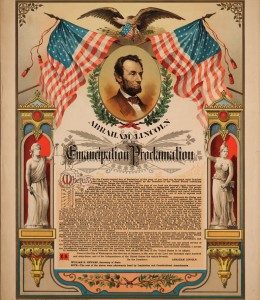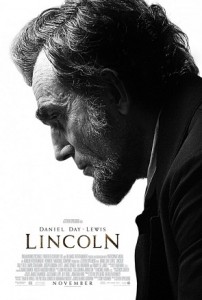 Abraham Lincoln issued The Emancipation Proclamation on January 1, 1863 freeing many slaves. Its scope was limited and its true legality unclear. Lincoln had freed the slaves in areas of rebellion with an executive order. His constitutional authority to do this was in question. For slavery to be abolished with certainty in the United States, a constitutional amendment was needed.
Abraham Lincoln issued The Emancipation Proclamation on January 1, 1863 freeing many slaves. Its scope was limited and its true legality unclear. Lincoln had freed the slaves in areas of rebellion with an executive order. His constitutional authority to do this was in question. For slavery to be abolished with certainty in the United States, a constitutional amendment was needed.
In September, 1862 Lincoln actually used the threat of freeing the slaves as a carrot to entice Confederate states back into the Union. At that time Lincoln issued an Executive Order that would free slaves on January 1, 1863 in any rebellious Confederate State that had not returned to the Union. When January 1 arrived, the proclamation was issued, but slaves were freed were only in the 10 states that remained in rebellion. Slaves in Border States (Missouri, Kentucky, Maryland, Delaware) that remained in the Union1 were still slaves after the Proclamation was issued.
Political Considerations
Congressional elections would take place in the fall of 1862. Political considerations appear to have been at play in the two step process. Slavery’s abolition was not a universal goal in the country. Lincoln set a freedom date after the election. Slave states that had remained in the Union were not affected. Had any Confederate state returned to the Union prior to January 1, under the terms of the Proclamation those slaves would not be freed. Though Lincoln had moved on abolition in a way to protect the Republican Party, in the 1862 House elections the party lost its majority. In the 1864 presidential election, Lincoln lost Kentucky and Delaware, but won Missouri and Maryland.
Lincoln’s Authority and Constitutional Recognition of Slavery
From a legal standpoint Lincoln relied on constitutional war powers in the Constitution’s Article II, section 2, in freeing the slaves.2 His legal authority to do this was questioned. Whether the proclamation could be legally effective if the war ended was unsettled. As the Civil War was drawing to a close there was a need to clarify the legal status of slavery in the United States.
The legality of slavery had been implicitly recognized in the Constitution. Slaves were counted for congressional representation, though each slave was considered as 2/3 of a person. There was a constitutional protection of the slave trade for the first fifteen years of the new government. The Constitution mandated the return of escaped slaves from Free States to Slave States. If there was to be a total prohibition of slavery in peacetime, it would have to be by constitutional amendment.
Thirteenth Amendment Proposal in Congress Not Automatic
The total abolition of slavery was not a simple a process. For a constitutional amendment to be sent to the states for ratification it requires a 2/3 majority of each house of Congress. The Senate approved the proposed Thirteenth Amendment in April, 1864. However, the House rejected the amendment when put to a vote on June 15, 1864. In his 1864 re-election bid, Lincoln’s party platform endorsed abolition by constitutional amendment. After his re-election approval of the amendment by the House became his top priority.3
 The Senate approval of April, 1864 remained valid after the fall elections, but only if the House approved before new members were sworn in. Otherwise the process would have to begin again. It became critical to win approval from the “lame duck”4 House. Lincoln and his team relied upon every executive power and present at their disposal to obtain votes. It is said direct bribery of House members took place. The story is related in the 2012 movie, Lincoln. Actor Daniel Day Lewis was nominated for an Academy Award for his portrayal of the 16th President.
The Senate approval of April, 1864 remained valid after the fall elections, but only if the House approved before new members were sworn in. Otherwise the process would have to begin again. It became critical to win approval from the “lame duck”4 House. Lincoln and his team relied upon every executive power and present at their disposal to obtain votes. It is said direct bribery of House members took place. The story is related in the 2012 movie, Lincoln. Actor Daniel Day Lewis was nominated for an Academy Award for his portrayal of the 16th President.
The Thirteenth Amendment’s Ratification
After the significantly questionable lobbying efforts of Lincoln and his team, the House approved the proposed amendment on January 31, 1865. Every Republican in the House voted for the amendment and slavery’s abolition. 3/4 of the Democrats voted against it.
In the aftermath of the House action, Congressman Thaddeus Stevens5 has been quoted as saying: “the greatest measure of the nineteenth century was passed by corruption, aided and abetted by the purest man in America”
Lincoln would not live to see the amendment added to the Constitution. On December 6, 1865 Georgia became the twenty-seventh state of the then thirty-six to ratify the 13th Amendment. Secretary of State Seward, on December 18, 1865, certified that the Thirteenth Amendment had become valid, to all intents and purposes, as a part of the Constitution. The Thirteenth Amendment reads as follows:
Section 1. Neither slavery nor involuntary servitude, except as a punishment for crime whereof the party shall have been duly convicted, shall exist within the United States, or any place subject to their jurisdiction.
Section 2. Congress shall have the power to enforce this article by appropriate legislation.
Involuntary Servitude Defined
Congress ultimately did enact laws to define involuntary servitude. These definitions go beyond the traditional understanding of slavery and include the concepts of obtaining labor by:
- Threatening or using actual physical force
- Threatening or using actual state-imposed legal coercion
- Physically restraining or threatening to physically restrain another person
- Destroying, concealing, removing, confiscating or possessing any actual or purported passport or other immigration document, or any other actual or purported government identification document, of another person
- Blackmail
- Causing or threatening to cause financial harm to any person
The Thirteenth Amendment began the process of legally erasing the largest inconsistency between the promise of America’s founding and the reality of slavery.
____________________________________________________________________________________
1Though Tennessee had seceded and was a slave state, it was largely under Union control, and slaves in Tennessee were not freed by the proclamation. Additionally, the slaves were not freed in the 68 Virginia counties that would become West Virginia and parts of Louisiana under Union control.
2This was an additional consideration in limiting emancipation to areas in rebellion, under the theory that martial law applied in those areas and Lincoln could rely on his authority as commander-in-chief.
3Concerns remained that in a post-war setting the Emancipation Proclamation would be invalid, and there remained legal questions if it was actually valid in the states in rebellion.
4“Lame duck” refers to office holders who have lost elections, but have not completed their term of office.
5Actor Tommie Lee Jones played Congressman Stevens in the movie. He seemed to take pure delight in delivering that quote.






[…] the end of the Civil War in 1865 and 1870, the US Constitution was amended three times. The Thirteenth, Fourteenth and Fifteenth Amendments are collectively known as the Reconstruction Amendments. The […]